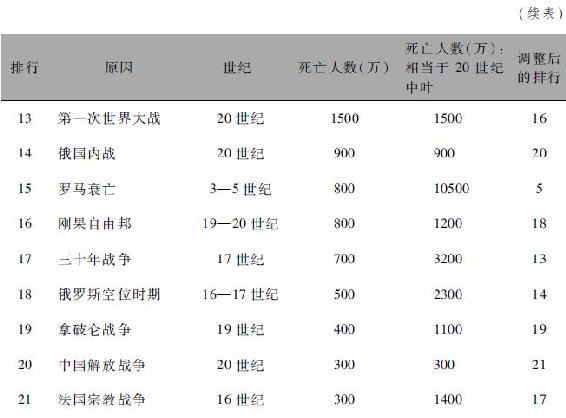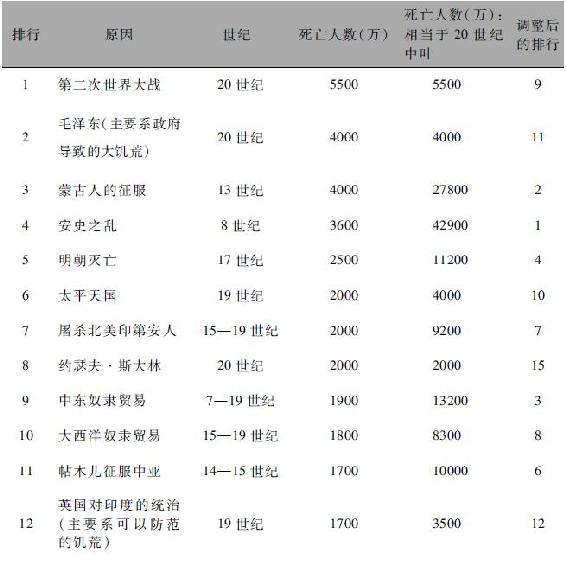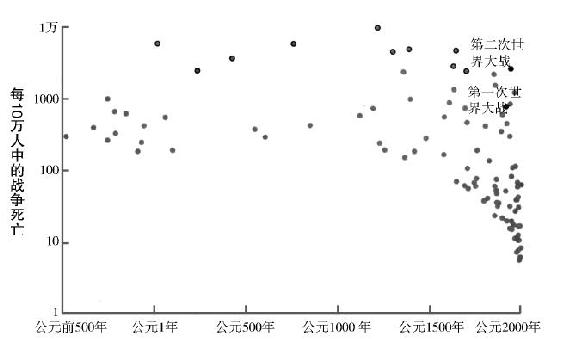(2) 20世纪真的是最糟糕的世纪吗? Was the 20th Century Really the Worst? | 人性中的善良天使
1 / 12
The first is that while the 20th century certainly had more violent deaths than earlier ones, it also had more people. The population of the world in 1950 was 2.5 billion, which is about two and a half times the population in 1800, four and a half times that in 1600, seven times that in 1300, and fifteen times that of 1 CE. So the death count of a war in 1600, for instance, would have to be multiplied by 4.5 for us to compare its destructiveness to those in the middle of the 20th century.
查看中文翻译
"The twentieth century was the bloodiest in history" is a cliché that has been used to indict a vast range of demons, including atheism, Darwin, government, science, capitalism, communism, the ideal of progress, and the male gender. But is it true? The claim is rarely backed up by numbers from any century other than the 20th, or by a mention of the hemoclysms of centuries past. The truth is that we will never really know which was the worst century, because it's hard enough to pin down death tolls in the 20th century, let alone earlier ones. But there are two reasons to suspect that the bloodiest-century factoid is an illusion.
查看中文翻译
(2) 20世纪真的是最糟糕的世纪吗? Was the 20th Century Really the Worst? | 人性中的善良天使
2 / 12
The second illusion is historical myopia: the closer an era is to our vantage point in the present, the more details we can make out. Historical myopia can afflict both common sense and professional history. The cognitive psychologists Amos Tversky and Daniel Kahneman have shown that people intuitively estimate relative frequency using a shortcut called the availability heuristic: the easier it is to recall examples of an event, the more probable people think it is. People, for example, overestimate the likelihoods of the kinds of accidents that make headlines, such as plane crashes, shark attacks, and terrorist bombings, and they underestimate those that pile up unremarked, like electrocutions, falls, and drownings. When we are judging the density of killings in different centuries, anyone who doesn't consult the numbers is apt to overweight the conflicts that are most recent, most studied, or most sermonized. In a survey of historical memory, I asked a hundred Internet users to write down as many wars as they could remember in five minutes. The responses were heavily weighted toward the world wars, wars fought by the United States, and wars close to the present. Though the earlier centuries, as we shall see, had far more wars, people remembered more wars from the recent centuries.
查看中文翻译
(2) 20世纪真的是最糟糕的世纪吗? Was the 20th Century Really the Worst? | 人性中的善良天使
3 / 12
When one corrects for the availability bias and the 20th-century population explosion by rooting around in history books and scaling the death tolls by the world population at the time, one comes across many wars and massacres that could hold their head high among 20th-century atrocities. The table on page 195 is a list from White called "(Possibly) The Twenty (or so) Worst Things People Have Done to Each Other." Each death toll is the median or mode of the figures cited in a large number of histories and encyclopedias. They include not just deaths on the battlefield but indirect deaths of civilians from starvation and disease; they are thus considerably higher than estimates of battlefield casualties, though consistently so for both recent and ancient events. I have added two columns that scale the death tolls and adjust the rankings to what they would be if the world at the time had had the population it did in the middle of the 20th century.
查看中文翻译
First of all: had you even heard of all of them? (I hadn't.) Second, did you know there were five wars and four atrocities before World War I that killed more people than that war? I suspect many readers will also be surprised to learn that of the twenty-one worst things that people have ever done to each other (that we know of), fourteen were in centuries before the 20th. And all this pertains to absolute numbers. When you scale by population size, only one of the 20th century's atrocities even makes the top ten. The worst atrocity of all time was the An Lushan Revolt and Civil War, an eight-year rebellion during China's Tang Dynasty that, according to censuses, resulted in the loss of two-thirds of the empire's population, a sixth of the world's population at the time.
查看中文翻译
(2) 20世纪真的是最糟糕的世纪吗? Was the 20th Century Really the Worst? | 人性中的善良天使
4 / 12


These figures, of course, cannot all be taken at face value. Some tendentiously blame the entire death toll of a famine or epidemic on a particular war, rebellion, or tyrant. And some came from innumerate cultures that lacked modern techniques for counting and record-keeping. At the same time, narrative history confirms that earlier civilizations were certainly capable of killing in vast numbers. Technological backwardness was no impediment; we know from Rwanda and Cambodia that massive numbers of people can be murdered with low-tech means like machetes and starvation. And in the distant past, implements of killing were not always so low-tech, because military weaponry usually boasted the most advanced technology of the age. The military historian John Keegan notes that by the middle of the 2nd millennium BCE, the chariot allowed nomadic armies to rain death on the civilizations they invaded. "Circling at a distance of 100 or 200 yards from the herds of unarmored foot soldiers, a chariot crew -- one to drive, one to shoot -- might have transfixed six men a minute. Ten minutes' work by ten chariots would cause 500 casualties or more, a Battle of the Somme-like toll among the small armies of the period."
查看中文翻译
(2) 20世纪真的是最糟糕的世纪吗? Was the 20th Century Really the Worst? | 人性中的善良天使
5 / 12
There is something indescribably revolting in the cold savagery with which the Mongols carried out their massacres. The inhabitants of a doomed town were obliged to assemble in a plain outside the walls, and each Mongol trooper, armed with a battle-axe, was told to kill so many people, ten, twenty or fifty. As proof that orders had been properly obeyed, the killers were sometimes required to cut off an ear from each victim, collect the ears in sacks, and bring them to their officers to be counted. A few days after the massacre, troops were sent back into the ruined city to search for any poor wretches who might be hiding in holes or cellars; these were dragged out and slain.
查看中文翻译
High-throughput massacre was also perfected by mounted hordes from the steppes, such as the Scythians, Huns, Mongols, Turks, Magyars, Tatars, Mughals, and Manchus. For two thousand years these warriors deployed meticulously crafted composite bows (made from a glued laminate of wood, tendon, and horn) to run up immense body counts in their sackings and raids. These tribes were responsible for numbers 3, 5, 11, and 15 on the top-twenty-one list, and they take four of the top six slots in the population-adjusted ranking. The Mongol invasions of Islamic lands in the 13th century resulted in the massacre of 1.3 million people in the city of Merv alone, and another 800,000 residents of Baghdad. As the historian of the Mongols J. J. Saunders remarks:
查看中文翻译
(2) 20世纪真的是最糟糕的世纪吗? Was the 20th Century Really the Worst? | 人性中的善良天使
6 / 12
The Mongols' first leader, Genghis Khan, offered this reflection on the pleasures of life: "The greatest joy a man can know is to conquer his enemies and drive them before him. To ride their horses and take away their possessions. To see the faces of those who were dear to them bedewed with tears, and to clasp their wives and daughters in his arms." Modern genetics has shown this was no idle boast. Today 8 percent of the men who live within the former territory of the Mongol Empire share a Y chromosome that dates to around the time of Genghis, most likely because they descended from him and his sons and the vast number of women they clasped in their arms. These accomplishments set the bar pretty high, but Timur Lenk (aka Tamerlane), a Turk who aimed to restore the Mongol Empire, did his best. He slaughtered tens of thousands of prisoners in each of his conquests of western Asian cities, then marked his accomplishment by building minarets out of their skulls. One Syrian eyewitness counted twenty-eight towers of fifteen hundred heads apiece.
查看中文翻译
(2) 20世纪真的是最糟糕的世纪吗? Was the 20th Century Really the Worst? | 人性中的善良天使
7 / 12
The worst-things list also gives the lie to the conventional wisdom that the 20th century saw a quantum leap in organized violence from a peaceful 19th. For one thing, the 19th century has to be gerrymandered to show such a leap by chopping off the extremely destructive Napoleonic Wars from its beginning. For another, the lull in war in the remainder of the century applies only to Europe. Elsewhere we find many hemoclysms, including the Taiping Rebellion in China (a religiously inspired revolt that was perhaps the worst civil war in history), the African slave trade, imperial wars throughout Asia, Africa, and the South Pacific, and two major bloodlettings that didn't even make the list: the American Civil War (650,000 deaths) and the reign of Shaka, a Zulu Hitler who killed between 1 and 2 million people during his conquest of southern Africa between 1816 and 1827. Did I leave any continent out? Oh yes, South America. Among its many wars is the War of the Triple Alliance, which may have killed 400,000 people, including more than 60 percent of the population of Paraguay, making it proportionally the most destructive war in modern times.
查看中文翻译
(2) 20世纪真的是最糟糕的世纪吗? Was the 20th Century Really the Worst? | 人性中的善良天使
8 / 12

A list of extreme cases, of course, cannot establish a trend. There were more major wars and massacres before the 20th century, but then there were more centuries before the 20th. Figure 5-3 extends White's list from the top twenty-one to the top hundred, scales them by the population of the world in that era, and shows how they were distributed in time between 500 BCE and 2000 CE.
查看中文翻译
FIGURE 5-3: 100 worst wars and atrocities in human history
查看中文翻译
Source: Data from White, in press, scaled by world population from McEvedy & Jones, 1978, at the midpoint of the listed range. Note that the estimates are not scaled by the duration of the war or atrocity. Circled dots represent selected events with death rates higher than the 20th-century world wars (from earlier to later): Xin Dynasty, Three Kingdoms, fall of Rome, An Lushan Revolt, Genghis Khan, Mideast slave trade, Timur Lenk, Atlantic slave trade, fall of the Ming Dynasty, and the conquest of the Americas.
查看中文翻译
(2) 20世纪真的是最糟糕的世纪吗? Was the 20th Century Really the Worst? | 人性中的善良天使
9 / 12
Two patterns jump out of the splatter. The first is that the most serious wars and atrocities -- those that killed more than a tenth of a percent of the population of the world -- are pretty evenly distributed over 2,500 years of history. The other is that the cloud of data tapers rightward and downward into smaller and smaller conflicts for years that are closer to the present. How can we explain this funnel? It's unlikely that our distant ancestors refrained from small massacres and indulged only in large ones. White offers a more likely explanation:
查看中文翻译
Maybe the only reason it appears that so many were killed in the past 200 years is because we have more records from that period. I've been researching this for years, and it's been a long time since I found a new, previously unpublicized mass killing from the Twentieth Century; however, it seems like every time I open an old book, I will find another hundred thousand forgotten people killed somewhere in the distant past. Perhaps one chronicler made a note long ago of the number killed, but now that event has faded into the forgotten past. Maybe a few modern historians have revisited the event, but they ignore the body count because it doesn't fit into their perception of the past. They don't believe it was possible to kill that many people without gas chambers and machine guns so they dismiss contrary evidence as unreliable.
查看中文翻译
(2) 20世纪真的是最糟糕的世纪吗? Was the 20th Century Really the Worst? | 人性中的善良天使
10 / 12
And of course for every massacre that was recorded by some chronicler and then overlooked or dismissed, there must have been many others that were never chronicled in the first place.
查看中文翻译
A failure to adjust for this historical myopia can lead even historical scholars to misleading conclusions. William Eckhardt assembled a list of wars going back to 3000 BCE and plotted their death tolls against time. His graph showed an acceleration in the rate of death from warfare over five millennia, picking up steam after the 16th century and blasting off in the 20th. But this hockey stick is almost certainly an illusion. As James Payne has noted, any study that claims to show an increase in wars over time without correcting for historical myopia only shows that "the Associated Press is a more comprehensive source of information about battles around the world than were sixteenth-century monks." Payne showed that this problem is genuine, not just hypothetical, by looking at one of Eckhardt's sources, Quincy Wright's monumental A Study of War, which has a list of wars from 1400 to 1940. Wright had been able to nail down the starting and ending month of 99 percent of the wars between 1875 to 1940, but only 13 percent of the wars between 1480 and 1650, a telltale sign that records of the distant past are far less complete than those of the recent past.
查看中文翻译
(2) 20世纪真的是最糟糕的世纪吗? Was the 20th Century Really the Worst? | 人性中的善良天使
11 / 12
If it were only a matter of missing a few small wars that escaped the notice of ancient chroniclers, one might be reassured that the body counts were not underestimated, because most of the deaths would be in big wars that no one could fail to notice. But the undercounting may introduce a bias, not just a fuzziness, in the estimates. Keegan writes of a "military horizon." Beneath it are the raids, ambushes, skirmishes, turf battles, feuds, and depredations that historians dismiss as "primitive" warfare. Above it are the organized campaigns for conquest and occupation, including the set-piece battles that war buffs reenact in costume or display with toy soldiers. Remember Tuchman's "private wars" of the 14th century, the ones that knights fought with furious gusto and a single strategy, namely killing as many of another knight's peasants as possible? Many of these massacres were never dubbed The War of Such-and-Such and immortalized in the history books. An undercounting of conflicts below the military horizon could, in theory, throw off the body count for the period as a whole. If more conflicts fell beneath the military horizon in the anarchic feudal societies, frontiers, and tribal lands of the early periods than in the clashes between Leviathans of the later ones, then the earlier periods would appear less violent to us than they really were.
查看中文翻译
The historian Rein Taagepera quantified the myopia in a different way. He took a historical almanac and stepped through the pages with a ruler, measuring the number of column inches devoted to each century. The range was so great that he had to plot the data on a logarithmic scale (on which an exponential fade looks like a straight line). His graph, reproduced in figure 5-4, shows that as you go back into the past, historical coverage hurtles exponentially downward for two and a half centuries, then falls with a gentler but still exponential decline for the three millennia before.
查看中文翻译
(2) 20世纪真的是最糟糕的世纪吗? Was the 20th Century Really the Worst? | 人性中的善良天使
12 / 12
Source: Data from Taagepera & Colby, 1979, p. 911.
查看中文翻译
So when one adjusts for population size, the availability bias, and historical myopia, it is far from clear that the 20th century was the bloodiest in history. Sweeping that dogma out of the way is the first step in understanding the historical trajectory of war. The next is to zoom in for a closer look at the distribution of wars over time -- which holds even more surprises.
查看中文翻译

FIGURE 5-4: Historical myopia: Centimeters of text per century in a historical almanac
查看中文翻译